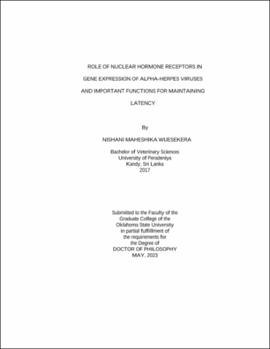| dc.contributor.advisor | Jones, Clinton | |
| dc.contributor.author | Wijesekera, Nishani Maheshika | |
| dc.date.accessioned | 2023-08-30T19:45:29Z | |
| dc.date.available | 2023-08-30T19:45:29Z | |
| dc.date.issued | 2023-05 | |
| dc.identifier.uri | https://hdl.handle.net/11244/339047 | |
| dc.description.abstract | Bovine alphaherpesvirus 1 (BoHV-1) and human alphaherpesvirus 1 (HSV-1) establish life-long latency following acute infection. BoHV-1 can cause abortion in cattle and reactivation from latency frequently occurs during latter stages of pregnancy. During pregnancy, progesterone (P4) levels increase: consequently, I hypothesized P4 stimulates BoHV-1 reactivation from latency. My studies demonstrated, P4 stimulates productive infection in the presence of the progesterone receptor (PR). Since steroid receptors can increase expression of Krüppel like factor (KLF) family members, the cooperative effects of PR with KLF members were examined. My studies revealed BoHV-1 infected cell protein 0 (bICP0) early promoter is cooperatively transactivated by PR and KLF4. For reactivation to occur, a pool of neurons must be maintained at the site of latency i.e., trigeminal ganglia (TG). Latency related transcript (LRT) is abundantly expressed during latency and encodes a protein (ORF2). Surprisingly, ORF2 mRNA suppresses glucocorticoid receptor (GR) mediated transactivation of immediate early transcription unit 1 (IEtu1) promoter. Since IE gene expression is a key event in productive infection, I hypothesized ORF2 mRNA could inhibit productive infection as well. My studies revealed ORF2 RNA also inhibits the GR, KLF15 and DEX mediated productive infection. Furthermore, a host signaling pathway, Akt supports latency. Since Akt family members inhibit GR or/and KLF15 mediated transactivation of the BoHV-1 IE promoters I hypothesized that Akt does this by influencing GR protein expression. My study demonstrated, Akt-1 reduced GR expression in mouse neuronal cells. | |
| dc.description.abstract | HSV-1 reactivation from latency can cause recurrent ocular disease, oral-facial lesions (cold sores, and life-threatening encephalitis). The ICP0 protein is expressed under immediate early conditions and is a crucial transcriptional regulatory protein. The ICP0 full length promoter is cooperatively transactivated by GR, KLF15 and DEX. Consequently, I hypothesized that the ICP0 promoter contains independent cis-regulatory modules (CRMs) that are transactivated by GR, KLF15 and DEX. These studies revealed three independent CRMs within the ICP0 promoter were transactivated by GR, KLF15 and DEX and consensus specificity protein 1 (Sp1) were required for transactivation. Collectively, these studies demonstrate that nuclear hormone receptors and KLF members increase the incidence of BoHV-1 and HSV-1 reactivation from latency. | |
| dc.format | application/pdf | |
| dc.language | en_US | |
| dc.rights | Copyright is held by the author who has granted the Oklahoma State University Library the non-exclusive right to share this material in its institutional repository. Contact Digital Library Services at lib-dls@okstate.edu or 405-744-9161 for the permission policy on the use, reproduction or distribution of this material. | |
| dc.title | Role of nuclear hormone receptors in gene expression of alpha-herpes viruses and important functions for maintaining latency | |
| dc.contributor.committeeMember | Oomens, Tom | |
| dc.contributor.committeeMember | Bauermann, Fernando Vicosa | |
| dc.contributor.committeeMember | Wozniak, Karen | |
| osu.filename | Wijesekera_okstate_0664D_18128.pdf | |
| osu.accesstype | Open Access | |
| dc.type.genre | Dissertation | |
| dc.type.material | Text | |
| dc.subject.keywords | bovine alphaherpesvirus 1 | |
| dc.subject.keywords | human alphaherpesvirus 1 | |
| dc.subject.keywords | latency | |
| dc.subject.keywords | nuclear hormone receptors | |
| dc.subject.keywords | reactivation | |
| dc.subject.keywords | stress | |
| thesis.degree.discipline | Veterinary Biomedical Sciences | |
| thesis.degree.grantor | Oklahoma State University | |
